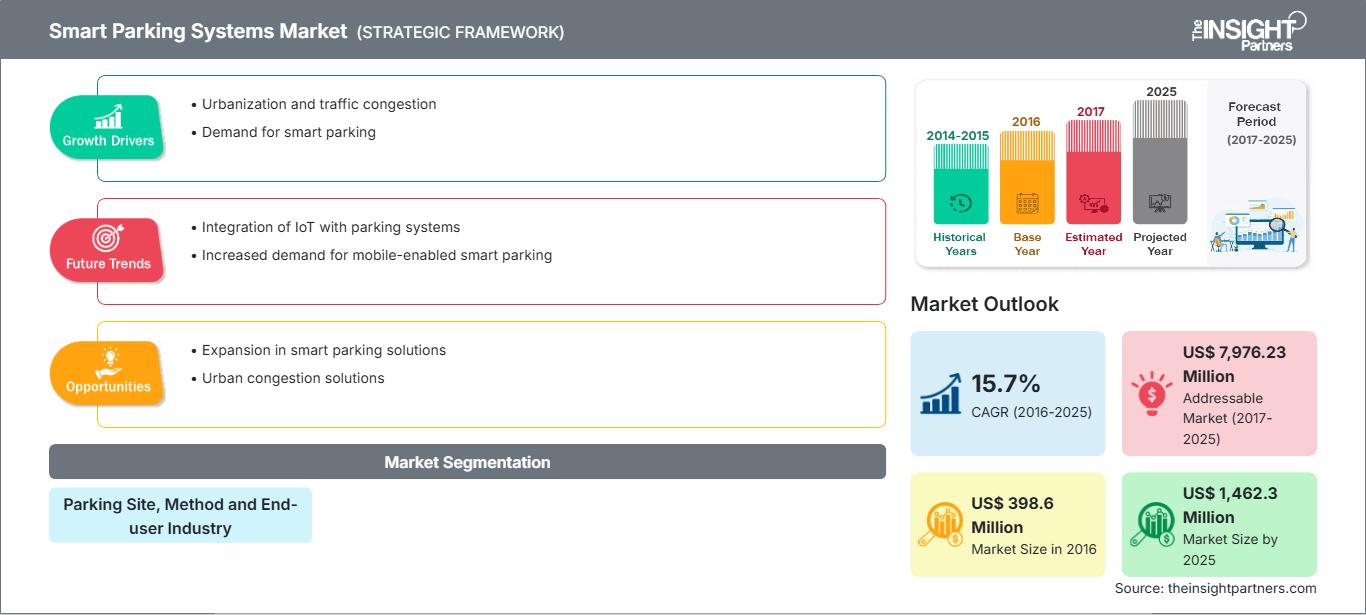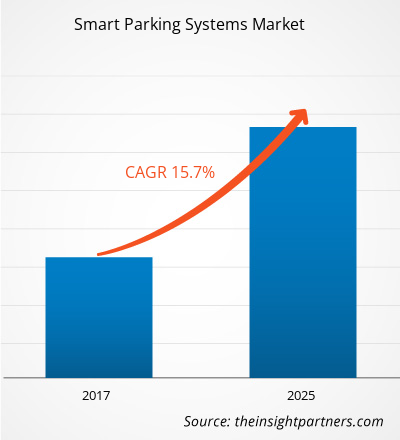Le marché des systèmes de stationnement intelligents était évalué à 398,6 millions de dollars américains en 2016 et devrait atteindre 1 462,3 millions de dollars américains d'ici 2025 ; il devrait croître à un TCAC de 15,7 % entre 2017 et 2025.
Le stationnement est un problème difficile, en particulier dans le paysage urbain, où 30 % à 40 % de tous les embouteillages sont principalement causés par les conducteurs qui peinent à trouver une place de stationnement. L'augmentation du nombre de véhicules circulant sur la route, la taille croissante des véhicules dans le segment des véhicules de luxe et la diminution des places de stationnement disponibles influencent les embouteillages, ce qui en fait un problème alarmant à l'échelle mondiale. De plus, la disponibilité limitée des données nécessaires pour guider les décisions d'un conducteur a tendance à faire perdre beaucoup de temps, ce qui alimente par la suite les problèmes de stationnement dans les zones urbaines. Cela cause également des dommages environnementaux tels que l'augmentation des émissions de dioxyde de carbone, la pollution sonore et la contamination des sols. Ces problèmes de stationnement impactent également les revenus des commerces locaux en zone urbaine. Faute de places de stationnement adéquates, de nombreux commerces de proximité voient leurs activités diminuer considérablement, impactant directement leurs revenus.
Le stationnement est un secteur majeur, générant un chiffre d'affaires mondial de plus de 100 milliards de dollars, et le marché des systèmes de stationnement intelligents apparaît comme un marché potentiel attractif pour les acteurs du stationnement, qu'ils soient déjà bien établis ou nouveaux. Ce marché connaît actuellement une croissance fulgurante dans plusieurs régions développées et devrait connaître une croissance exponentielle dans d'autres régions du monde au cours des prochaines années.
Analyses du marché - Marché des systèmes de stationnement intelligents
Croissance de la mise en œuvre de programmes de villes intelligentes basés sur l'IoT
Une ville intelligente exploite la puissance de la technologie pour gérer ses processus de manière efficace et fluide, faisant du système de stationnement intelligent un élément essentiel de son infrastructure. Les technologies intelligentes possèdent un potentiel considérable pour optimiser les actifs les plus critiques de leurs clients et assurer un développement responsable en améliorant l'efficacité, en augmentant les revenus et en contribuant à un avenir durable. Le graphique ci-dessous illustre la part des investissements réalisés dans divers aspects critiques des villes intelligentes, où les transports intelligents enregistrent une croissance significative. Le stationnement, préoccupation majeure du secteur des transports modernes, devrait bénéficier d'une attention accrue dans les années à venir. L'un des aspects les plus utiles d'une ville intelligente est l'utilisation de la technologie pour simplifier la circulation et le stationnement.
Analyse des segments de stationnement
Le marché des systèmes de stationnement intelligent se divise en stationnement hors voirie et stationnement sur voirie. Le stationnement sur voirie désigne le stationnement des véhicules en bordure de route et est principalement contrôlé par les agences gouvernementales. En revanche, dans le stationnement hors voirie, les véhicules sont stationnés dans des garages ou des zones de stationnement spécifiques, contrôlés par des agences commerciales.
Informations sur les segments de composants
Les systèmes de stationnement intelligents se composent principalement de deux éléments : le matériel et les logiciels. Pour assurer le bon fonctionnement de ces deux éléments, des services sont fournis. Dans cette étude, nous avons donc segmenté le marché des systèmes de stationnement intelligents en trois composantes : le matériel, les logiciels et les services. Le chiffre d'affaires total du marché mondial des systèmes de stationnement intelligents comprend les revenus cumulés provenant de ces trois composantes.
Informations sur les segments des industries utilisatrices
Selon les industries utilisatrices, le marché des systèmes de stationnement intelligents est segmenté en installations de transport, administrations publiques et municipales, institutions commerciales et entreprises. Les aéroports, dans les installations de transport, sont les principaux contributeurs au marché des systèmes de stationnement intelligents. La fréquentation élevée de ces lieux et la gestion des places de stationnement étant devenue une priorité, les installations de transport captent la majeure partie du marché. Toutefois, les autorités gouvernementales initient également l’adoption du stationnement intelligent pour les espaces de stationnement publics tels que le stationnement sur rue et les garages publics.
Vous bénéficierez d’une personnalisation sur n’importe quel rapport - gratuitement - y compris des parties de ce rapport, ou une analyse au niveau du pays, un pack de données Excel, ainsi que de profiter d’offres exceptionnelles et de réductions pour les start-ups et les universités
Marché des systèmes de stationnement intelligents: Perspectives stratégiques

- Obtenez les principales tendances clés du marché de ce rapport.Cet échantillon GRATUIT comprendra une analyse de données, allant des tendances du marché aux estimations et prévisions.
Les acteurs du marché se concentrent sur les innovations et les développements de nouveaux produits en intégrant des technologies et des fonctionnalités avancées dans leurs produits pour rivaliser avec la concurrence.
2017 : Amano Mcgann a étendu son partenariat avec l'un de ses plus anciens concessionnaires PSX au Colorado. 2017 : Valeo et Cisco ont annoncé un accord de coopération pour développer des innovations stratégiques dans les services de mobilité intelligente. 2017 : Smart Parking a annoncé avoir remporté un nouveau contrat en Nouvelle-Zélande, choisi par Wilson Parking New Zealand comme fournisseur privilégié de technologies de capteurs et de recherche de places sur neuf nouveaux sites. 2017 : Smart Parking a lancé sa nouvelle passerelle IoT SmartSpot, avec des fonctionnalités nouvelles et améliorées adaptées aux besoins des villes intelligentes.
Aperçu régional du marché des systèmes de stationnement intelligents
Les tendances régionales et les facteurs influençant le marché des systèmes de stationnement intelligents tout au long de la période de prévision ont été analysés en détail par les analystes de The Insight Partners. Cette section aborde également les segments et la géographie du marché des systèmes de stationnement intelligents en Amérique du Nord, en Europe, en Asie-Pacifique, au Moyen-Orient et en Afrique, ainsi qu'en Amérique du Sud et en Amérique centrale.
Portée du rapport sur le marché des systèmes de stationnement intelligents
| Attribut de rapport | Détails |
|---|---|
| Taille du marché en 2016 | US$ 398.6 Million |
| Taille du marché par 2025 | US$ 1,462.3 Million |
| TCAC mondial (2016 - 2025) | 15.7% |
| Données historiques | 2014-2015 |
| Période de prévision | 2017-2025 |
| Segments couverts |
By Site de stationnement, méthode et industrie d'utilisation finale |
| Régions et pays couverts | Amérique du Nord
|
| Leaders du marché et profils d'entreprises clés |
|
Densité des acteurs du marché des systèmes de stationnement intelligent : comprendre son impact sur la dynamique des entreprises
Le marché des systèmes de stationnement intelligents connaît une croissance rapide, portée par une demande croissante des utilisateurs finaux, due à des facteurs tels que l'évolution des préférences des consommateurs, les avancées technologiques et une meilleure connaissance des avantages du produit. Face à cette demande croissante, les entreprises élargissent leur offre, innovent pour répondre aux besoins des consommateurs et capitalisent sur les nouvelles tendances, ce qui alimente la croissance du marché.

- Obtenez le Marché des systèmes de stationnement intelligents Aperçu des principaux acteurs clés
- Analyse historique (2 ans), année de base, prévision (7 ans) avec TCAC
- Analyse PEST et SWOT
- Taille du marché Valeur / Volume - Mondial, Régional, Pays
- Industrie et paysage concurrentiel
- Ensemble de données Excel
Rapports récents
Témoignages
Raison d'acheter
- Prise de décision éclairée
- Compréhension de la dynamique du marché
- Analyse concurrentielle
- Connaissances clients
- Prévisions de marché
- Atténuation des risques
- Planification stratégique
- Justification des investissements
- Identification des marchés émergents
- Amélioration des stratégies marketing
- Amélioration de l'efficacité opérationnelle
- Alignement sur les tendances réglementaires






















 Obtenez un échantillon gratuit pour - Marché des systèmes de stationnement intelligents
Obtenez un échantillon gratuit pour - Marché des systèmes de stationnement intelligents